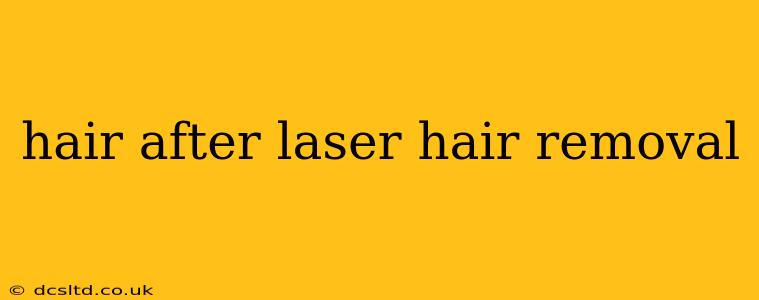Laser hair removal is a popular cosmetic procedure promising smooth, hair-free skin. However, understanding what happens to your hair after the treatment is crucial for optimal results and avoiding potential complications. This comprehensive guide covers everything you need to know about hair growth and aftercare following laser hair removal.
What Happens to Hair After Laser Hair Removal?
Immediately after the procedure, you might experience some redness and swelling, similar to a mild sunburn. This is normal and usually subsides within a few hours or days. The treated hair follicles will typically remain intact for a short period before shedding naturally. This shedding often starts within a week or two and can continue for several weeks. You shouldn't try to pull out the hairs; let them fall out naturally. Importantly, the results aren't instantaneous. Laser hair removal requires multiple sessions to achieve significant, long-term hair reduction, not complete elimination.
How Long Does it Take for Hair to Fall Out After Laser Hair Removal?
The timeframe for hair falling out varies depending on several factors, including the area treated, your hair type, and the settings used during the laser treatment. Generally, you'll start to see hair shedding within a week or two, but it can take several weeks for the majority of treated hairs to fall out. Be patient; the process unfolds gradually.
Does Hair Grow Back After Laser Hair Removal?
While laser hair removal significantly reduces hair growth, it doesn't guarantee permanent hair removal for everyone. Hair can grow back, but it usually grows back finer, sparser, and lighter in color. The regrowth is often so minimal that it's barely noticeable. Multiple sessions are key to maximizing the long-term effects and minimizing regrowth.
Why Does Hair Grow Back After Laser Hair Removal?
Hair regrowth after laser hair removal is primarily due to the fact that the laser doesn't target all hair follicles at once, and some follicles might not be effectively deactivated. Also, hormonal fluctuations can influence hair growth patterns. Furthermore, some hairs might be in a resting phase during the treatment and not be susceptible to the laser's effects until they enter an active growth phase in a later session.
How to Care for Your Skin After Laser Hair Removal?
Proper aftercare is crucial to maximize results and minimize the risk of complications. This includes:
- Avoid sun exposure: Sun exposure can irritate the treated area and increase the risk of hyperpigmentation (dark spots). Always apply a broad-spectrum sunscreen with an SPF of 30 or higher.
- Keep the area clean and dry: Gently cleanse the treated area with mild soap and water. Avoid harsh scrubbing or exfoliation.
- Avoid hot water and harsh products: Hot showers and harsh soaps can irritate the skin. Opt for lukewarm water and gentle cleansers.
- Avoid certain activities: Avoid activities that might cause excessive sweating or friction on the treated area, such as intense workouts or tight clothing.
- Follow your dermatologist's instructions: Your dermatologist will provide specific post-treatment instructions tailored to your individual needs. Adhering to these instructions is crucial.
What are the potential side effects of laser hair removal?
Possible side effects of laser hair removal are generally mild and temporary. These might include redness, swelling, and mild discomfort. In rare cases, more serious side effects like blistering, scarring, or changes in skin pigmentation might occur. Always consult with a qualified dermatologist to discuss any concerns you might have before undergoing treatment.
By following proper aftercare guidelines and understanding the process of hair regrowth after laser hair removal, you can optimize your results and enjoy smoother, more confident skin. Remember that patience is key, and consistent treatment sessions are necessary for achieving long-term hair reduction.
